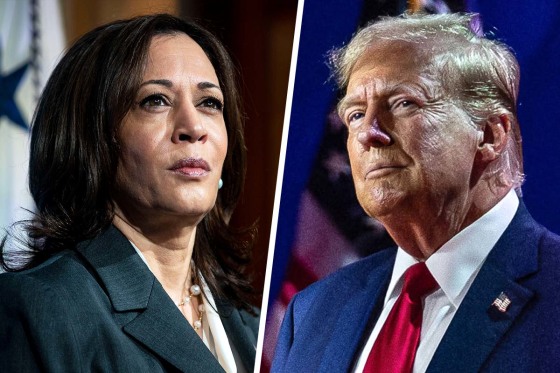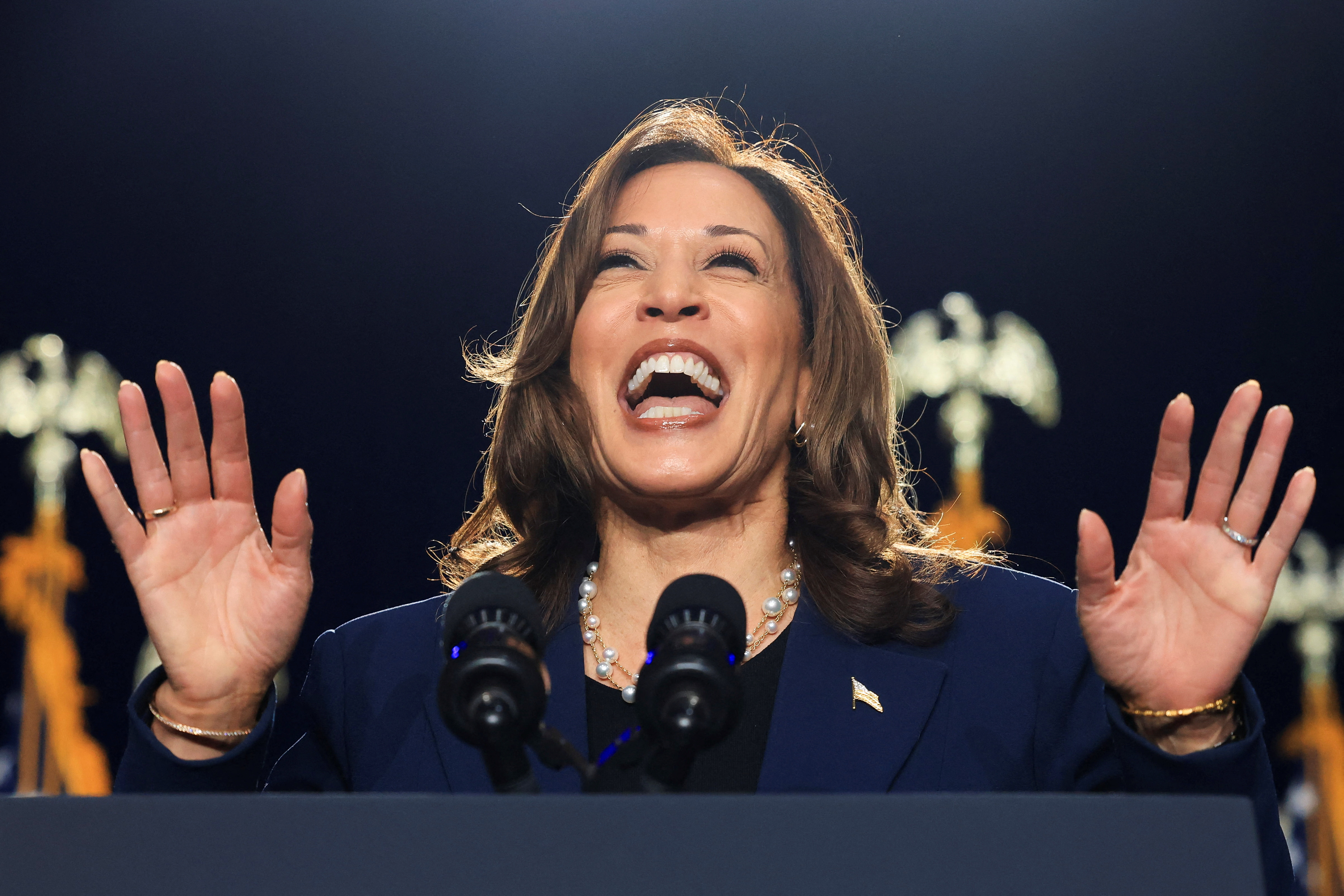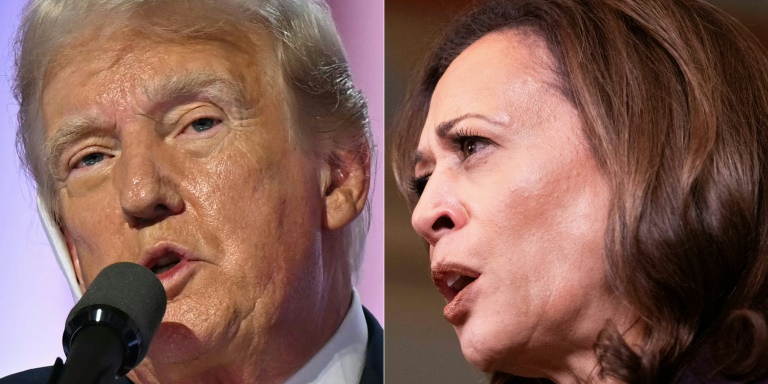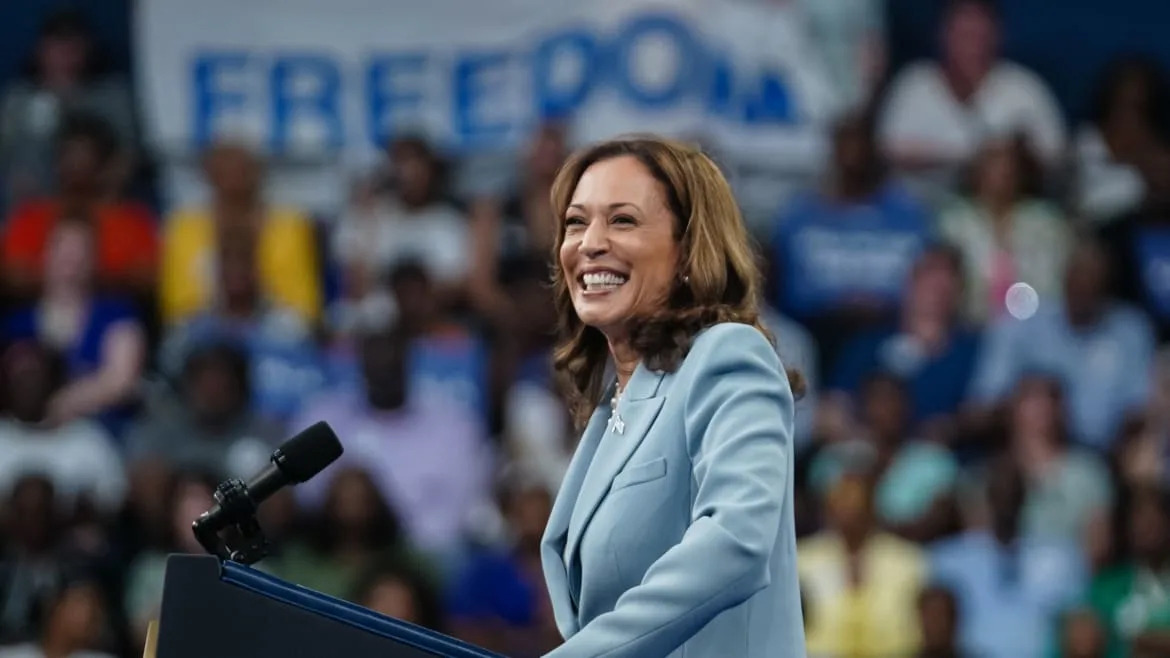 As of Sunday, Vice President Kamala Harris, the likely Democratic presidential nominee, leads former President Donald Trump in this year’s tight election in three major national polling aggregators.
As of Sunday, Vice President Kamala Harris, the likely Democratic presidential nominee, leads former President Donald Trump in this year’s tight election in three major national polling aggregators.
The polls come two weeks after President Joe Biden’s unprecedented decision to withdraw from the race and endorse Harris. Since then, she has garnered widespread support from the party and is poised to lead the Democratic ticket in November.
With the biggest lead for Harris, FiveThirtyEight’s national aggregator poll puts her 1.6 percentage points above Trump in the national election, with 45.3 percent to Trump’s 43.7 percent.
Aggregate polls are constantly updated as new polling data is added, shifting the averages in real time.

Nate Silver’s Silver Bulletin presidential forecast shows Harris with a slightly narrower lead, at 45.5 percent compared to Trump’s 44.1 percent. According to the model, Harris pulled ahead of Trump on July 31, by 0.2 percent, and has been slowly increasing her lead since.
Race to the WH, shows the smallest lead for Harris, just .2 percent above Trump. It shows Harris garnering 47.3 percent and Trump 47.1 percent. If third-party candidates are included, the forecast shows Harris pulling ahead at 44.7 percent, Trump at 43.7 percent, Robert F. Kennedy Jr. at 5.7 percent, and Cornel West at 0.7 percent.

However, three other national aggregate polls show Trump leading Harris, such as The New York Times, which finds Trump ahead of Harris by 1 point, 48 to 47 percent. However, when third-party candidate Robert F. Kennedy Jr. is included in the poll, Harris and Trump drop to an even 44 percent.
Similarly, The Hill’s aggregation, based on 97 polls, shows Trump leading Harris by 1.1 percentage points, with 47.6 percent to her 46.5 percent, while RealClearPolitics shows Trump with a 0.8 percent lead, at 47.7 percent to Harris’ 46.9 percent.
All of the aggregate polls reveal a nail-biting presidential election where candidates are constantly inching up or down based on new poll inclusions.

The presidential election is determined by Electoral College votes. Candidates must secure 270 electoral votes to win the presidency, which is not always accurately reflected in national aggregate polls, as state-specific victories are necessary to secure electoral votes.
Individual polls of battleground states, which often carry a significant number of electoral votes, also show a tight race between Trump and Harris.
A recent CBS News/YouGov survey of 3,102 registered voters, conducted between July 30 and August 2, shows Harris leading in one battleground state, Trump leading in three, and a tie in three other swing states.

The United States presidential election will be held on November 5. Election analyst Nate Silver’s national poll aggregate has Democratic nominee and current vice president Kamala Harris leading Republican nominee and former president Donald Trump by 45.5–44.1%, with 5.0% for Robert F. Kennedy Jr.
When President Joe Biden withdrew from the contest on July 21, Trump had a 45.2–41.2% lead over Biden, so Harris has improved on Biden’s net margin by 5.4 points. By the election, Biden will be almost 82, Trump is now 78 and Harris will be 60.
Silver’s model gave Trump a 73% chance to win the election when Biden was his opponent. When the Harris vs Trump model was launched last Tuesday, Trump had a 62% chance to win. The model now gives Harris very slight favouritism, with a 50.5% chance to win.
The US president isn’t elected by the national popular vote, but by the Electoral College, in which each state receives electoral votes based mostly on population. Almost all states award their electoral votes winner takes all, and it takes 270 electoral votes to win (out of 538 total).
Silver’s model gives Harris a 66% chance to win the popular vote, compared to a 50.5% chance in the Electoral College. The model indicates Harris needs to win the popular vote by at least two points to be the favourite to win the Electoral College.
It’s still very close to a 50–50 chance for either Harris or Trump, but Harris has greatly improved on the situation under Biden. Switching from Biden to Harris was clearly the correct decision for Democrats.
In economic data, the unemployment rate rose 0.2% to 4.3% in July, the highest it has been since October 2021, when the US was recovering from the COVID recession. A weaker economy is likely to assist Trump.

Australian politics: the inflation report
The Australian Bureau of Statistics released the June quarter inflation report on July 31.
Inflation increased 1%, the same as in the March quarter, for a 12-month rate of 3.8%. However, the trimmed mean and weighted median measures of core inflation were both lower than headline inflation at 0.8% in the June quarter.
The ABC reported economists thought an interest rate rise was unlikely after this inflation report, and the next interest rate move is much more likely to be down, though not until early 2025.
The cost of living has been by far voters’ biggest concern, so this report is modest good news for Labor. The polls below include a bad Redbridge poll for Labor that was conducted in mid-July.
Essential poll: Labor gains to be just ahead

A national Essential poll, conducted July 24–28 from a sample of 1,137, gave Labor a 47–46% lead including undecided, a reversal of a 48–46% Coalition lead in mid-July.
Primary votes were 34% Coalition (up one), 32% Labor (up three), 11% Greens (down two), 7% One Nation (down one), 2% UAP (down one), 9% for all Others (steady) and 6% undecided (steady).
This is the second Labor lead in Essential’s fortnightly polls since April. Labor’s poor position in this poll has been partly due to weak respondent allocated preference flows.
Anthony Albanese had a -3 net approval, up six points since early July, with 46% disapproving and 43% approving. Peter Dutton’s net approval improved two points to +1.
By 56–36%, Australians had an unfavourable opinion of Trump, a large improvement for Trump from 72–20% unfavourable after the 2020 US election. By 48–25%, they had a favourable opinion of Harris. By 37–23%, voters thought Australia’s relationship with the US would become worse if Trump is elected president.
On union membership, 11% said they were currently union members, 28% were not currently members but had been previously and 58% had never been a member. By 64–26%, voters thought unions important (60–24% in 2020). By 51–26%, they thought workers would be better off with stronger unions (50–24% in 2020).
Labor’s relationship with unions was thought too close by 33%, about right by 33% and not close enough by 10%.
Morgan poll: 50.5–49.5% to Labor

A national Morgan poll, conducted July 15–21 from a sample of 1,752, gave the Coalition a 51–49% lead, a 0.5-point gain for the Coalition since the July 8–14 poll.
In the Morgan poll conducted July 22–28 from a sample of 1,652, Labor led by 50.5–49.5%.
Primary votes were 37.5% Coalition (down two since July 15–21), 30.5% Labor (down one), 13% Greens (steady), 6.5% One Nation (up 1.5), 8.5% independents (up one) and 4% others (up 0.5).
Using preferences allocated by 2022 election flows, Labor led by 51–49%, a 0.5-point gain for Labor.
Redbridge poll: big swing to Coalition gives them lead
A national Redbridge poll, conducted July 10–19 from a sample of 1,505, gave the Coalition a 51.5–48.5% lead, a 3.5-point gain for the Coalition since a Redbridge April poll.
Primary votes were 41% Coalition (up four), 32% Labor (down one), 11% Greens (down one) and 16% for all Others (down two).
By 48–27%, voters did not think the Albanese government was focused on the right priorities (50–34% in April). By 40–34%, they did not think the Coalition led by Dutton is ready for government (45–36% previously).
By 38–37%, voters opposed the development of nuclear power plants, but by 33–29% they thought the Coalition had a better plan than Labor for future energy reliability and affordability.
YouGov poll: 51–49% to Labor
A national YouGov poll, conducted July 12–17 from a sample of 1,528, gave Labor a 51–49% lead, a one-point gain for Labor since the previous YouGov poll in early June.
Primary votes were 38% Coalition (steady), 31% Labor (up one), 13% Greens (down one), 7% One Nation (down one) and 11% for all Others (up one).
Albanese’s net approval improved two points to -10, with 52% satisfied and 42% dissatisfied. Dutton’s net approval surged nine points to -4. Albanese led as preferred PM by 45–37% (47–36% in June).
When asked whether they could name something the government had done to make them personally financially better off, 73% said “no” and 27% “yes”, with tax cuts the most popular at 10%. Asked the same question in a poll before the May budget, 82% had responded “no”.
In additional questions from the previous YouGov poll, 31% had a leaning towards more capitalism, 27% towards more socialism and 42% were neutral. By 50–27%, voters thought the government should support low-cost airlines.

Vice President Kamala Harris has overtaken former President Donald Trump in the race for the presidency for the first time in the calculations of one of the nation’s most popular poll watchers.
According to a model published by Nate Silver’s substack on Sunday, Harris has now taken a slight lead against Trump for the presidential election in November—though the election remains a “toss-up” by Silver’s own estimations.
Silver’s model, which compiles the results of statewide polls and weights them based on reliability, showed Trump polling ahead of the Democratic candidate for most of July—including during the weeks immediately after President Joe Biden dropped out of the race. Harris began to lead the former president on July 31, according to the data published on Sunday.
Harris now leads Trump with 45.5% of the expected vote, compared to Trump’s 44.1%.
According to Silver’s calculations, Harris now has 50.5% chance to win the general election, compared to Trump’s 48.8%. Harris also now has a 65.9% chance to win the popular vote—but the predicted elector share remains close, with the vice president only beating Trump by about 18 votes in the Electoral College.
Harris Blew Trump’s Fundraising Numbers Out of the Water in July
The same model had independent candidate Robert F. Kennedy Jr. polling at about 5% in the general election.
Silver founded the popular polling blog FiveThirtyEight in 2008, but left the website in May 2023.
:max_bytes(150000):strip_icc():focal(749x0:751x2)/Kamala-Harris-donald-trump-070224-5afbef0acac94ca882d0b67134871e6e.jpg)
FiveThirtyEight’s most recent polling averages are almost identical to Silver’s. In a model published on Friday, the blog now published by ABC News had Harris slightly leading Trump with 45% of the vote, compared to the former president’s 43.5%. The election is too close to predict, FiveThirtyEight concluded.
Silver has a mixed record with calling elections. FiveThirtyEight gave Biden an 89% chance at defeating Trump in the 2020 presidential election—a bold prediction that eventually proved accurate. However, he also gave Hilary Clinton a 71% chance of winning on the eve of the 2016 general election.
Silver’s newsletter was published after a week of promising polls for the vice president showed Harris gaining an advantage in key swing states. A Bloomberg/Morning Consult poll published last Tuesday showed Harris leading Trump by single-digits in Arizona, Wisconsin, and Nevada, and leading by a staggering 11 points in Michigan.
The same survey showed Trump ahead in Pennsylvania and North Carolina, and the two candidates tied in Georgia.
However, other models have not shown Harris taking the lead over the last week. The New York Times’ poll tracker still has Trump leading the vice president in Pennsylvania and Michigan, with the pair tied in Wisconsin. The Times’ model has Trump ahead by one point in the general election—but that lead shrinks to a draw if you include Kennedy.




